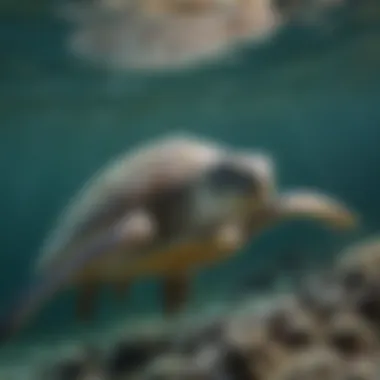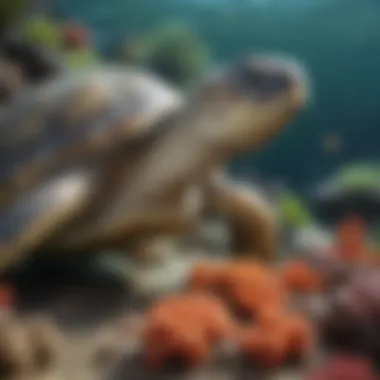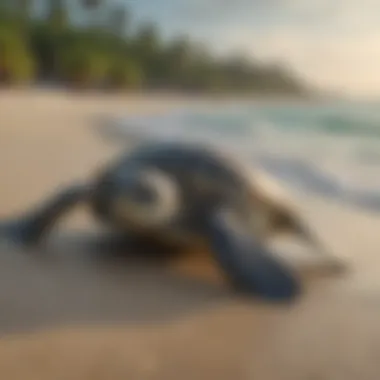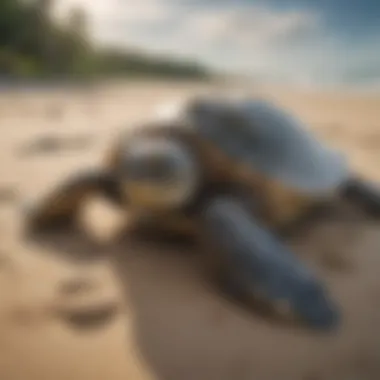Understanding the Lifespan of Green Sea Turtles


Nature Topic Overview
Green sea turtles are fascinating creatures found in warm ocean waters around the world. Understanding their lifespan is crucial for appreciating their role in marine ecosystems. These turtles can live for several decades, with some reaching over 80 years of age. Their long lifespan allows them to play a significant role in the health of our oceans, such as grazing on seagrass, which helps to maintain the vitality of these underwater plants.
The life cycle of green sea turtles is divided into several stages: hatchlings, juveniles, and adults. Every stage presents unique challenges. Hatchlings, for example, face numerous threats as they make their way from the nest to the ocean. Once in the sea, they must evade predators and find safe habitats to grow and develop. As adults, green sea turtles continue to face dangers from human activity, including habitat destruction and pollution, which can significantly impact their lifespan and overall population.
Research shows that the longevity of green sea turtles is influenced by various factors. Naturally, predators and environmental conditions play a vital role. However, human-induced factors, such as climate change and the impact of fisheries, are increasingly becoming notable threats.
Fun Facts and Trivia
- Did you know that green sea turtles can hold their breath for up to five hours while diving? This helps them find food and evade predators.
- Unlike many other turtles, green sea turtles are herbivores. Their diet mainly consists of seagrass and algae, making them essential for marine habitats.
- Baby turtles are known as hatchlings. They weigh only about 2 ounces (57 grams) at birth and are only about two inches (5 cm) long!
"Green sea turtles are among the few turtle species that exhibit long-distance migrations, traveling thousands of miles between feeding and nesting grounds."
Wildlife Explorations
In addition to the green sea turtle, there are other marine species that share the ocean habitat. For example, loggerhead turtles and hawksbill turtles also inhabit similar waters. Each species has its own unique adaptations and life cycles.
Many plants and animals coexist with sea turtles. Seagrass meadows support diverse marine life and are crucial for the survival of turtles. Understanding the interconnections within these environments is essential for conservation efforts.
Environmental Awareness
Conservation plays a key role in extending the lifespan of green sea turtles. As human activities continue to affect ocean health, it is important to promote sustainable practices. Here are some tips:
- Reduce plastic use to prevent marine pollution.
- Support sea turtle conservation organizations.
- Spread awareness about the importance of ocean habitats among friends and family.
Encouraging children to take small steps in protecting the environment can lead to a healthier planet for future generations.
DIY Nature Activities
Engaging with nature can be both fun and educational. Here are some hands-on activities:
- Turtle Tracking: Create a simple map to track local wildlife, including turtles, in nearby bodies of water. Research to see how far these animals travel.
- Crafting Turtle Shells: Use recycled materials to make turtle shells. Teach kids about the anatomy of turtles while creating a fun craft.
- Seagrass Garden: Plant a small garden of aquatic plants at home or in a community space. It helps show the importance of seagrass in marine ecosystems.
These activities foster a connection with nature and enhance understanding of the green sea turtle’s environment.
Preamble to Green Sea Turtles
Green sea turtles are fascinating marine reptiles that play a significant role in their ecosystems. Understanding these creatures requires knowledge of their characteristics, habitats, and contributions to marine life. This article aims to explore the lifespan of green sea turtles, recognizing its importance in the context of their survival and ecological role.
Basic Characteristics
Green sea turtles are known for their distinctive appearance. They have a large, rounded shell, which varies in color from olive to dark green. Their size can range from three to four feet long, and they can weigh between 200 to 400 pounds. These turtles have strong flippers that allow them to swim gracefully through ocean waters, and they primarily feed on seagrasses and algae. Their beak-like jaws are adapted for grazing on these plants.
Understanding their basic characteristics helps in comprehending their needs and behaviors. For instance, these turtles are ectothermic, meaning their body temperature depends on the environment. This affects their activity levels, feeding habits, and breeding cycles. It also influences their migration patterns as they seek warmer waters.
Natural Habitat
Green sea turtles are found in a variety of marine environments. Their natural habitat includes tropical and subtropical oceans, typically around coral reefs, lagoons, and coastal areas. These turtles prefer waters with temperatures between 70°F to 85°F. The presence of seagrass beds is crucial for their diet and serves as nesting sites for females.
Habitat quality greatly affects their lifespan. Polluted waters can lead to health issues, while loss of nesting beaches due to human activities poses a threat. Conservation efforts focus on protecting these habitats to ensure the survival and well-being of green sea turtles.


In summary, understanding the basic characteristics and natural habitats of green sea turtles provides a foundation for appreciating their lifespan. These reptiles not only enrich marine ecosystems but also reflect the health of their environment.
Lifespan of Green Sea Turtles
Average Lifespan
The average lifespan of green sea turtles is typically between 60 and 80 years. However, many variables can affect this duration. Factors like habitat quality, food availability, and overall health contribute to their life expectancy. In a safe and nurturing environment, these turtles are more likely to reach the upper limits of their lifespan. In some cases, these factors can even enable them to live longer.
A notable aspect affecting lifespan is the presence of predators. In the wild, young turtles face significant threats from animals like sharks and birds. As they mature, these risks often decrease. Adult turtles become much less vulnerable, making survival into old age more likely. Nonetheless, illness and environmental challenges still pose substantial risks throughout their lives.
Record Longevity
Green sea turtles have demonstrated astonishing longevity in rare cases. Some individuals have been documented living over 100 years. This record is significant as it indicates the potential of these creatures to thrive under ideal conditions. While such ages are uncommon, they emphasize the importance of protecting habitats and ecosystems. When environments are healthy, these turtles have a better chance to grow old.
Monitoring efforts provide valuable data on the ages of green sea turtles. Research shows that, like many animals, their growth slows as they age. The exact age can sometimes be determined through analysis of their shells. Tagging programs and studies offer important insights into their behaviors and lifespan. These records help shape conservation policies aimed at preserving these ancient marine reptiles.
In summary, the lifespan of green sea turtles is multifaceted and reveals much about their biology and ecosystem interaction. Average lifespans can extend from 60 to over a hundred years, depending on a variety of factors. Knowing these details enhances appreciation for these creatures and underlines the need for effective conservation strategies.
Life Cycle Stages
Understanding the life cycle stages of green sea turtles is essential to grasp how they grow and develop over time. Each stage of their life contributes to their overall longevity and helps us comprehend the challenges they face. With each phase, green sea turtles accumulate experiences and encounters that influence their survival and adaptability in aquatic ecosystems. Awareness of these stages can also aid in conservation efforts aimed at protecting these magnificent creatures.
Egg Stage
The egg stage represents the beginning of a green sea turtle’s life. Female turtles typically nest on sandy beaches, laying between 100 to 200 eggs in a single clutch. This stage lasts about 60 days, depending on environmental conditions. Temperature plays a crucial role in determining the sex of hatchlings; warmer eggs often result in females, while cooler ones lean towards males. These embryos develop in the relative safety of their eggs, but many face dangers like predation from birds and other wildlife. Thus, the survival rate from eggs to hatchlings is remarkably low, making this stage very critical for the population.
Hatchling Stage
Once the incubation period concludes, hatchlings emerge from their eggs, signaling the start of their journey. This stage lasts from the moment they dig their way to the surface until they reach the ocean. After they break free, hatchlings must navigate the various threats on land, including predators like crabs and birds. The instinctual drive to reach the ocean is essential, as this is where they will start their life in the sea. They rely on an innate compass, guided by the moon's reflection on the water to find their way. Survival rates during this stage remain very low, as many hatchlings do not survive the initial dash to safety.
Juvenile Stage
Exiting the hatchling phase, green sea turtles enter the juvenile stage, which may last several years. They often seek refuge in coastal areas where seagrasses and algae grow. This stage is characterized by growth and development. Juveniles can be identified by their smaller size and are more vulnerable to predators. During this period, turtles start adjusting to their diets, which mainly consist of seagrasses and various types of algae. Finding adequate food sources is vital for them to thrive. Their success in adapting and growing will significantly determine their future.
Adult Stage
The adult stage marks the culmination of their life’s growth and maturation. Green sea turtles reach sexual maturity about 20 to 50 years old, depending on environmental factors and individual growth rates. Adults are typically larger, and they often migrate to nesting sites, displaying strong site fidelity. In this stage, they contribute significantly to the health of marine ecosystems. Adults play a vital role in maintaining the balance of seagrass beds, which are important habitats for various marine organisms. At this point in their lives, green sea turtles face fewer natural predators due to their size, although anthropogenic threats continue to pose risks. Their longevity in this phase can extend many decades, underscoring the importance of their conservation.
Factors Influencing Lifespan
The lifespan of green sea turtles is influenced by several critical factors. Understanding these factors is essential for recognizing the challenges these turtles face in their natural habitats. The intricate relationships between environmental conditions, predation risks, and human impact create a complex web affecting how long green sea turtles can live.
Environmental Conditions
Green sea turtles thrive in warm ocean waters. Their habitats include coral reefs, seagrass beds, and coastal areas. These environments offer food sources, such as seagrass and algae. However, environmental conditions can change due to several reasons. Climate change can alter water temperatures and disrupt the balance of ecosystems. Changes in weather patterns can also impact nesting beaches, which are crucial for the survival of the species. Protecting these habitats ensures that green sea turtles have suitable conditions to live and reproduce.
Predation Risks
Predation is a natural threat in the life of a green sea turtle. While adult turtles have few natural predators, young hatchlings and juveniles are at significant risk. Birds, crabs, and fish can all prey on smaller turtles. This life stage is critical, as the survival of hatchlings greatly influences population numbers. The higher the predation rates, the lower the chances for juvenile turtles to grow into adults. Conservation practices that help to ensure safer hatching sites can reduce these risks.
Human Impact


Human activities pose some of the greatest threats to green sea turtles. Pollution in the form of plastics and chemicals can poison turtles or entangle them in debris. Furthermore, habitat destruction due to coastal development impacts nesting areas, diminishing survival chances for hatchlings.
Fishing practices also contribute to turtle mortality. Bycatch occurs when turtles are unintentionally caught in fishing gear. Laws and regulations must be enforced to limit these harmful practices. By increasing awareness and promoting sustainable practices, it is possible to reduce the negative impacts on green sea turtles and support their longevity.
The lifespan of green sea turtles is intricately tied to these factors, making it necessary to address each one to ensure their survival.
Conservation Efforts
Conservation efforts play a crucial role in the survival and longevity of green sea turtles. These efforts focus on various practices and strategies to protect these remarkable creatures and their habitats. Understanding their significance helps shine a light on why it is essential to act now for future generations.
Protection of Habitats
Green sea turtles require specific habitats to thrive. The protection of their natural environments is paramount to ensuring their longevity. Coastal areas and marine ecosystems provide nesting grounds and feeding sites critical to their life cycle.
Some key points include:
- Safeguarding nesting beaches from pollution and human interference.
- Preserving seagrass beds which are vital food sources.
- Managing coastal development to prevent habitat destruction.
Legislation and policies can enforce these protective measures. When habitats are protected, green sea turtles can breed and feed without threats. Ultimately, this promotes healthier populations.
Legislation and Policies
Effective legislation is necessary for the protection of green sea turtles. Laws at local, national, and international levels can make significant impacts on their conservation. Some important laws include:
- The Endangered Species Act in the United States.
- International treaties such as the Convention on International Trade in Endangered Species of Wild Fauna and Flora (CITES).
Such regulations aim to protect turtles from illegal hunting and trade. They also promote the sustainable management of marine resources. Moreover, engaging in research allows policymakers to base decisions on scientific data, further aiding conservation efforts.
Community Involvement
Local communities can play a vital role in conservation efforts. Education and awareness programs lead to a deeper understanding of the importance of green sea turtles. Community members can contribute by:
- Participating in beach cleanups to reduce pollution.
- Supporting organizations that focus on turtle conservation.
- Advocating for protective policies within their regions.
"Every small action counts. Together, communities can make a difference!"
Promoting a sense of ownership over local resources encourages sustainable practices. When people understand the value of green sea turtles in the ecosystem, they are more likely to protect them.
In summary, conservation efforts are essential for the survival of green sea turtles. Protection of habitats, strong legislation, and community involvement form the backbone of these initiatives. By focusing on these areas, we can help secure a future for green sea turtles and ensure they thrive in their natural environments.
Threats to Longevity
Green sea turtles, like all species, face numerous challenges that can significantly shorten their lifespans. These threats stem from both natural and human-induced factors, making it crucial to understand their impact on the longevity of these magnificent marine reptiles. By exploring these threats, we can better comprehend the protective measures needed to ensure the survival of green sea turtles in their habitats.
Pollution
Pollution has become a pressing issue for the oceans, and it severely affects green sea turtles. Plastics and toxic substances in the water can harm their health. For instance, when green sea turtles mistake plastic items for food, it can lead to severe digestive problems. Ingested plastics can block the intestines, causing malnutrition or even death. Furthermore, toxins from industrial waste can accumulate in their bodies, causing long-term health issues.
Common pollutants include:
- Plastic debris: Bags, bottles, and other plastic items.
- Chemicals: Pesticides and heavy metals from runoff.
- Oil spills: These create toxic environments and affect the turtle's skin and lungs.
Education on the impact of pollution is essential. By raising awareness about pollution, we can encourage better practices and laws to protect the oceans. Small actions like proper waste disposal can make a significant difference.


Climate Change
Climate change is an overarching threat that influences various factors affecting green sea turtles. Rising ocean temperatures can harm their development and habitats. Nesting beaches are also at risk due to rising sea levels and increasing storm intensity. These changes can impact nesting success and hatchling survival rates.
The effects of climate change on green sea turtles include:
- Temperature-dependent sex determination: The temperature of the sand where eggs are laid can determine the sex of the hatchlings. Warmer sands may lead to more females, affecting future population balance.
- Loss of nesting habitat: Erosion from rising seas can wash away nesting sites, reducing the number of hatchlings.
- Coral reef degradation: Healthy reefs are vital for adult turtles to find food. Coral bleaching, caused by rising temperatures, threatens these ecosystems.
Green sea turtles are enduring numerous threats that jeopardize their longevity. By understanding pollution and climate change, we can take steps to protect these turtles and their habitats. It is important to foster a connection with nature and instill a sense of responsibility for preserving marine environments.
The Role of Green Sea Turtles in Ecosystems
Green sea turtles play a crucial role in maintaining the health and balance of marine ecosystems. Their presence impacts a variety of ecological processes, from seagrass bed maintenance to nutrient cycling. Understanding their role helps highlight the importance of conservation efforts aimed at protecting these reptiles and their habitats.
Ecological Contributions
Green sea turtles are primarily herbivorous, feeding on seagrasses and algae. This grazing activity helps maintain the health of seagrass meadows, which are vital ecosystems for many marine organisms, including fish and crustaceans. By eating seagrass, turtles promote the growth of new shoots, which allows these plants to thrive and continue providing important habitats. Moreover, healthy seagrass meadows improve water quality by stabilizing sediment and reducing nutrient runoff, benefiting entire marine ecosystems.
In addition to their feeding habits, the nesting behaviors of green sea turtles also contribute significantly to coastal and marine environments. When turtles come ashore to lay their eggs, they disturb the sand, aiding in nutrient cycling and providing a habitat for various organisms. This process creates a diverse living environment that supports various marine life.
Significance in Marine Food Webs
Green sea turtles hold a specific position within marine food webs. As grazers of seagrass and algae, they provide a food source for larger predators, such as sharks and large fish. In turn, their population impacts the dynamics of these predator-prey relationships. If the number of green sea turtles decreases, it can lead to overgrowth of seagrass and algae, potentially displacing other marine life and unbalancing the ecosystem.
Their role as a prey species also illustrates the interconnectedness of marine life. Healthy populations of green sea turtles indicate a stable environment. Protecting their existence ultimately helps maintain the overall health of marine ecosystems, benefitting both aquatic animals and coastal communities.
"The role of green sea turtles extends beyond their immediate habitat; they are integral to the well-being of the oceans they inhabit."
In summary, understanding the role of green sea turtles in ecosystems adds depth to our knowledge of marine conservation. Recognizing their contributions guides efforts to protect not only the turtles themselves, but also the wider marine environment that relies on their health and existence.
Research and Studies
Monitoring Lifespan
Monitoring the lifespan of green sea turtles involves tracking them throughout their lives. Researchers use various methods, such as satellite tracking and photo identification. These techniques allow scientists to gather data on the turtles’ movements, growth rates, and migration patterns. By knowing how long these turtles live in the wild, researchers can make better estimates.
Data collection over time helps to create a clearer picture of their life expectancy. For example, environmental changes and human activities can impact their health and longevity.
Findings from Tagging Programs
Tagging programs have provided vital insights into the lifespan of green sea turtles. When researchers tag turtles, they can monitor their movements and survival. Findings from these programs have shown that, in some regions, green sea turtles live longer than previously thought.
Tagging also reveals important data about their behavior and habitats. This information helps in understanding how they interact with their environment.
"Research on green sea turtles highlights the need for focused conservation efforts based on scientifically collected data."
These studies, combined with observations from various habitats, allow scientists to see patterns in age and survival rates.
Culmination
The Importance of Lifespan Knowledge
When we learn about the lifespan of green sea turtles, we uncover many facts. For example, green sea turtles can live for many decades—some estimates suggest that they can reach ages of up to 80 years or more. This longevity allows them to play a significant role in ocean ecosystems. Their long lives also mean they have more opportunities to reproduce, contributing to their population stability.
The lifespan of green sea turtles is influenced by a mixture of natural and human-related factors. Understanding these elements is essential for anyone interested in marine biology or conservation. Here are some key reasons why this knowledge is important:
- Ecological Role: Green sea turtles are vital to maintaining healthy seagrass beds, which provide habitats for other marine life.
- Conservation Strategies: Knowledge about their lifespan can lead to better protection measures, like creating marine protected areas where they can thrive.
- Education and Awareness: Sharing information about the lifespan of green sea turtles helps inspire the next generation to care about marine conservation.







